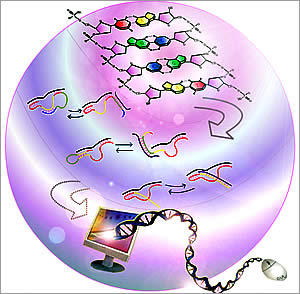
|

|
No.46 June, 2006 |
Cross-disciplinary Research Led to New DNA-based Logical Gates
Prof. Fan Chunhai, of the Shanghai Institute of Applied Physics (SINAP), CAS, based on cooperation with Prof. He Lin, member of CAS and Prof. Zhang Zhizhou (now Professor of the Tianjin University of Science & Technology) from the Shanghai Jiao Tong University (SJTU), succeeded in developing a new type of DNA-based Logical Gates by using deoxyribozyme (DNA zyme).

The DNA zyme is a specific structure of the nucleic acid with specific enzymatic bio-activity which is selected through in-vitro evolution. With this structure as its basis, the DNA-based Logical Gate is developed through modular designing. The DNA-based Logical Gate system highlights in excluding the participation of RNA nucleotide in its designing while merely using the DNA molecula. In this way, the instability in the system due to the RNA nucleotide will be avoided. The related research results have been reported in the Mar. 2006 issue of the German journal Angew. Chem . Int. Ed., 2006, 45, 1759.
Latest Research Results in Origin and Evolution of Osteichthyans
The May 4 issue of the British journal Nature reported that a team, led by Zhu Min, a Research Fellow from the Institute of Vertebrate Paleontology and Paleoanthropology (IVPP), CAS and Prof. Yu Xiaobo from the Kean University in US, had found a primitive fish and achieved latest research results concerning the origin and evolution of osteichthyans (bony fish). Their work provides a key information for studying the origin and early evolution of osteichthyans and unveils a possible morphotype for the common ancestor of actinopterygians (ray-finned bony fish) and sarcopterygians (lobe-finned bony fish) and the gradual process of the cosmine development.

The unique characters combination of Meemannia, the primitive fish, has wide implications for deeper study of osteichthyan phylogeny and the early divergence of actinopterygians and sarcopterygians. These characters unveil a possible morphotype for the ancestor of osteichthyans and that cosmine in crown-group sarcopterygians might have developed step by step. As for the biological functions of pore-canal system of cosmine, the discovery of Meemannia acts as a strong proof for vascular hypothesis. On this basis, Zhu Min and his co-workers had made a systematological analysis to Meemannia and believed that it could represent the most primitive sarcopterygians discovered up to now. The discovery of the new species of Meemannia lends further support to the hypothesis proposed by Zhu and his colleagues in 2001, revealing that the ancient South China area was the center of origin of lobe-finned fish (sarcopterygians).
New Mechanism for Neuron-synapse Development Discovered
The May 4 issue of Neuron reported in its cover story the research results concerning a new mechanism for neuron-synape development discovered by a research team, headed by Prof. Duan Shumin, Research Fellow from the Shanghai Institutes for Biological Sciences (SIBS), CAS and including Duan's doctorate students Shen Wanhua and Wu Pei, etc. It is the first time that Chinese scientists publish their research work as a cover story in this prestigious journal of international neurosciences filed.

The synapse is the key structure of the nervous system that transmits signals from one nerve cell to another. The research team has found that in its early development period, one kind of silent synapse fails to transmit signals between two nerve cells and the reason responsible for its silence lies in the pre-synaptic neuron that cannot release the transmission agent of glutamate acid, rather than the postsynaptic membrane, according to a classical interpretation, which has NMDA receptors but lacks the AMPA receptors. Also, the team discovered that the enhancement of the pre-synaptic activity can rapidly transform a "silent synapse" into a functional one. Their further research reveals that the transformation comes from the activation of the small G-protein CDCí¬42's signaling molecule, which promotes the releasing of glutamate acid.
Research Center for Behavioral Genetics Established
The Research Center for Behavioral Genetics officially opened at the Institute of Psychology (IP), CAS in Beijing on Apr. 5, 2006.
As a new research arm for the third phase of the Knowledge Innovation Program implemented in IP, the Center was established in compliance with national demands and academic disciplinary development edge. The Center will organize its team through introduction of talents. Prof. Sun Zhongsheng, Director of the Center was from the Cornell University and he had made major research breakthrough in the biological clock field before he joined the Center.
Starting from interactions between genetic and environmental factors, the Center will carry out in-depth and systematic studies on the interactive relationship between genetic and environmental factors and the genetic basis and environmental factors for the origination and development of complicated human behaviors from various aspects ranging from behavior, system, molecule and gene, etc. It will strive to reveal the causes for the behavioral origination and development, for the purpose of controlling, preventing and curing psychological and mental diseases.
Cloning Purified Conotoxin Succeeded
group of CAS scientists headed by Qi Zhengwu, member of CAS from the Institute of Biochemistry and Cell Biology under the CAS Shanghai Institutes for Biological Sciences, has succeeded in purifying many conotoxins and cloning more than 100 new genes from six species of cone snails living in the South China Sea. The related work has been honored with the first prize of Shanghai S&T Progress Awards 2005.
The South China Sea is rich in various cone snails. So far, there are about 500 species of small cone snails being identified, which are believed to be able to produce more than 50,000 kinds of conotoxins with different structures and functions. However, so far, only less than one percent of conotoxins have been identified. The species of cone snails are a promising and untapped treasure of biotoxin resource in China. The new drugs developed on basis of these conotoxins have shown potential of being widely applied to ease pains and treat epilepsy and other neuropathic diseases.
It is learned that the Food & Drug Administration (FDA) of US has ratified a kind of conotoxin to be used as a pain killer for advanced cancer sufferers, which has shown better analgesic efficacy than those common ones as morphine and dolantin but does not bear the addiction side-effect. So far, Chinese researchers have actively joined the international community in this field.copyright © 1998-2005
CAS Newsletter Editorial Board: 52, Sanlihe Road, Beijing 100864,
CHINA
Email: slmi@cashq.ac.cn